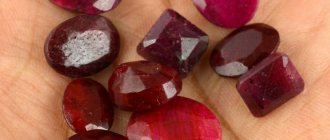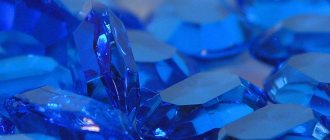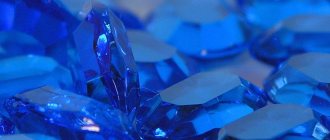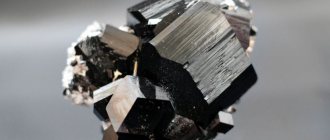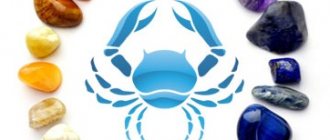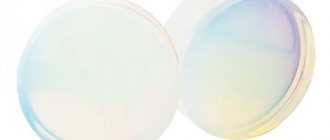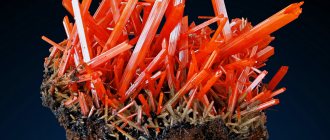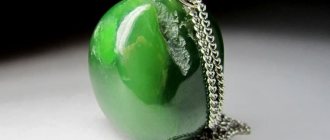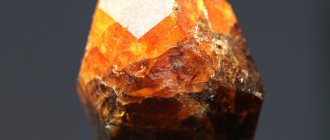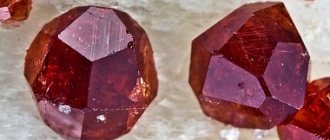Taaffeite (taffeite) is a rare precious mineral, the official history of which began only in the middle of the 20th century. In 1945, the attention of the Irish geologist E. Taafe was attracted by a pale lilac crystal located among other precious samples. After research, it became clear that the mineral does not belong to the already known groups of stones. It was named after the count and scientist Taafe and was included in the spinel group as an independent mineral. This is the only stone in the world that was first studied after cutting, and not as a rock.
Among the physical and chemical properties of taaffeite, one can note the peculiarity of dual refraction of light rays, as a result of which it shines through in several shades at the same time. A dense but fragile gem with a glassy luster often has a pyramidal or prismatic shape, with a conchoidal, uneven fracture.
The uniqueness of the stone is ensured by its complex chemical composition (Mg3Al8BeO16), which is based on shares of magnesium, beryllium and aluminum. Varieties of the mineral may contain impurities of zinc, iron and chromium.
Taaffeite deposits
Today, only two deposits of taaffeite are reliably known - Sri Lanka and Tanzania.
Specimens of the gem are very rare, but large crystals are often found among them. For example, one of the largest stones weighed 70 carats. — Advertising —
Occasionally, samples of taaffeite are found in countries such as China, Madagascar and Australia.
Place of Birth
The first pebble was found among the spinels. And today there are no separate deposits of taaffeite; it is found as an accompanying “highlight”:
- For a long time, transparent jewelry taaffeite was sorted only from an array of spinel mined in Sri Lanka near the city of Ratnapura. The deposits are considered rich, but over the entire period only three dozen reddish-purple stones have been found here.
- Today, jewelry taaffeite is supplied by Tanzania. However, the fat mines of Tundur produced only a few hundred stones over many years. Their dimensions are small, but there are eight-carat specimens. Nine-carat taaffeite is even rarer.
The record holders among taaffeites are Sri Lankan stones: uncut 71.1 carats and violet-purple faceted taffeite 10 carats. The largest cut musgravite weighs 5.93 carats.
- Raw materials from different places are of collectible and scientific interest: Russia (Karelia, Ural, Eastern Siberia), USA, Myanmar, Australia, Antarctica (Enderby Land).
- Crystal grains are found in metamorphically altered limestone strata throughout the planet. But they are not suitable for processing.
A variety of taaffeite is musgravite, 3.69 carats, mined in Tanzania.
An indication of the deposit and color is always included in the description of taaffeite.
History of Taaffeit
Taaffeite is a very young stone, and has been known since the middle of the last century.
Its discoverer, scientist Edward Taaffe, studied spinel. He examined the specimens and described them. And suddenly I discovered a pebble unlike other samples. It was distinguished by birefringence - an optical property absolutely not characteristic of spinel. To study it in more detail, Taaffe cut the find and sent it to colleagues in London, to the Mineralogical Department of the British Museum. There they came to the conclusion that the physical and chemical properties of the mineral are unique, that is, it represents a new species, which was named taaffeite in honor of Taaffe. Interestingly, taaffeite was the first mineral to be found in a research laboratory as a cut stone rather than a geological sample.
History of the mineral
Taaffeite stone belongs to a group of minerals named after the “father” - the discoverer:
- An Irish aristocrat for several generations, Richard Taaffe neglected social life. He was interested in beauty, primarily stones. Understanding the wisdom of gemology, he achieved success. And he became the discoverer of the rarest precious mineral.
- In 1945, while sorting through the contents of a box of spinel, Richard noticed one specimen. The pebble stood out slightly from the crowd in color. Taaffe decided to investigate it. He discovered double refraction, which, according to science, does not occur in spinels.
- The gemologist was not too lazy to send the curiosity to the British Museum for examination. But the sample was cut and experts did not immediately identify it. The owner allowed us to separate a piece from the pebble sufficient for in-depth analysis and identification.
Taaffeite is the only mineral examined as a jewelry insert, and not as a mineralogical sample.
- A complete chemical and structural analysis of the stone confirmed that this is a new product, unknown to science.
- Six years later, the rare stone was officially registered, named after the owner - taaffeite.
- Today, the name of the mineral officially assigned by the IMA classification is magnesiotaaffeite.
In everyday life and literature, two equivalent spellings are used: taffeit and taaffeit.
Physico-chemical characteristics of taaffeite
The chemical composition of taaffeite is quite complex and is a complex compound of magnesium, beryllium and aluminum.
Different varieties of the mineral contain zinc, iron or chromium as impurities. — Advertising —
Hardness on the Mohs scale 8.5, specific gravity 3.61 g/cm3. The color palette includes shades from pink to purple with varying degrees of brightness and saturation.
Taaffeite crystals are translucent, have a glassy luster and are birefringent, which is what distinguishes them from similar spinel.
Types of taaffeite
There are several subspecies of taaffeite with different structure, chemical composition, origin and impurity content.
- Musgravites (magnesiotaaffeites) are named after the location of the first discovery - the Musgrave mountain range, which is located in the central regions of Australia. It contains impurities of iron and zinc.
- Taprobanites are colored an exquisite sapphire blue and were found in Ceylon, which was formerly called Taprobana, hence the name.
- Ferrotaaffeites are analogues of musgravites, but contain a large amount of iron.
Horoscope compatibility
Astrologers, in terms of knowledge regarding this mineral, are not far behind the esotericists, however, the former identify four signs, the compatibility of which with the energy of taaffeite has already been established:
- Fish. For representatives of this sign, jewelry made from this stone will finally help them stop worrying about the most insignificant reasons and relax.
- The mineral will relieve hardworking and persistent Taurus from chronic fatigue, and will also encourage them to look at the world with a fresh look and try out some new life experiences.
- Thanks to the lilac crystal amulet, the lion's passion will be enough for even more things. Representatives of this sign will have time to solve all the problems, as they say, for themselves and for that guy, attend all the bohemian parties and help the maximum number of people who want to.
- For Libra, taaffeit is the best remedy for creative stagnation and depression.
Magical properties of taaffeite
It is believed that the magical properties of taaffeite are aimed at helping in the search for love and maintaining and harmonizing relationships in the family.
Taaffeit helps replace quarrels and mutual claims and resentments with respect and understanding. For this purpose, a man should wear a ring with a gem on the middle finger of his right hand, which must be removed periodically. Girls often try to bewitch the guys they like using taaffeit. Those who are looking for their soulmate are recommended to wear bracelets made of this mineral on their left hand.
Charms with stones become faithful helpers for everyone who is engaged in creative activities and crafts. An unprocessed piece of taaffeite will increase performance and help develop perseverance.
What are shamans talking about?
Esotericists believe that taaffeite belongs to that capricious caste of gems that can “choose” their owner: the energy of the stone can be fully felt only by a person with pure thoughts and a certain internal basic state of love for all things. The violet crystal will not serve vicious and evil people.
The same goes for apathetic lazy people - characters of this sort simply cannot cope with the power of the gem. But for an energetic subject, taaffeite jewelry and talismans promise deliverance from complexes that have long interfered with life, and will also help to reach a higher level of awareness, harmonize one’s existence in the broadest sense of this expression.
In addition, taaffeit brings good luck in everything: in relationships and in the professional field, it will help someone monetize their hobby.
But there is one nuance that it is advisable to listen to: products made from violet crystal are recommended for the most part to middle-aged and older people who are wise with experience, have strong self-control skills and clearly understand their desires. For young and ardent hearts prone to rashness, jewelry made from this gem can “help” commit a series of rash actions and, as a result, bring disappointment.
It is worth noting that taaffeite is not often used in magical practices due to its rarity and high cost, therefore its properties have not been studied well enough.
The healing properties of taaffeite
The main healing property that is characteristic of taaffeite is its ability to influence the emotional state of a person.
The lilac-pink color of the mineral has a beneficial effect on the nervous system, calms, improves mood and inspires optimism. Jewelry with this gem has the most effective effect in this direction. To normalize sleep and get rid of nightmares, it is recommended to sleep wearing a taaffeite bracelet. A pendant or ring with a mineral, worn throughout the day, will help raise vitality and increase performance. Taffeite also helps to harmonize a person’s inner world, prolongs the youth and beauty of women and increases potency in men.
Taaffeit and the signs of the Zodiac
Taaffeit ring
Among all the zodiac signs, no obvious favorites of Taaffeit, to whom he would treat in a special way, have so far been identified. It is believed that the gem pays a little more attention to representatives of the following signs:
- Taurus, a purposeful and hardworking Zodiac sign by nature, will learn to rationally distribute their forces with the help of the mineral, which will allow them to find time to rest and avoid overwork.
- Leos - will receive solar energy from the gem, which it is so rich in. This will allow them to help their loved ones solve their problems without compromising their own health.
- Libra - will develop perseverance and a craving for creativity, get rid of depressive mood, and gain self-confidence.
- Pisces will be able to harmonize their inner world, find peace, and learn to cope with emotions.
The influence of taffeite on other signs of the Zodiac has not yet been studied, but it is reliably known that the stone will not harm its owner. Back to contents
Taaffeite colors
Taaffeite is valuable not only because of its extreme rarity, but also because of its color palette. It varies from translucent soft pink to dark purple, and there are also almost colorless crystals with the slightest green or blue tint. Rare dark blue and red specimens are known.
ethnoscience
Lithotherapists compare violet crystals to a tuning fork in the arsenal of a musical instrument tuner, which allows them to detect and eliminate even hidden sound defects.
Traditional medicine specialists attribute a large number of healing properties to taaffeite, primarily related to the subtle sphere of the psyche.
Jewelry made from this mineral is recommended for people suffering from various neuropsychic illnesses, as they help get rid of anxiety and depression, insomnia and other oneiric disorders.
Lithotherapists have also established the effectiveness of taaffeite in stabilizing hormonal levels specifically in the sexual aspect, both in men and women. This means that jewelry made from purple gems will be beneficial for a huge number of very different delicate problems caused by hormonal imbalance: from obesity and acne to amenorrhea and erectile dysfunction.
In addition, purple crystals help strengthen the immune system, as well as accelerate regenerative processes in case of injuries of various origins and severity.
How to distinguish real taaffeit from a fake
Each found sample of taaffeite is subject to accounting and registration due to the rarity of the gem, so it is rarely counterfeited. When trying to create an imitation, they usually use spinel, a common, inexpensive mineral that looks similar to taaffeite. To distinguish such a fake, it is examined in bright light, while two shades will never appear in spinel, since birefringence is not typical for this mineral.
How is taaffeit presented on the market?
The natural area of application of the mineral is high jewelry. However, taffeite is found a million times less frequently than diamonds. This factor, plus the prohibitive cost of the stone, excludes mass production of jewelry. These things are made to order.
What they sometimes try to pass off as taaffeite is actually spinel. Stones can only be distinguished using special equipment.
Collectors are offered one-off material. Such cases are rare, we must not miss them.
How to care for taaffeit
Jewelry with taaffeite should not be worn constantly without taking it off, as this will cause the stones to lose their bright original color.
They are stored in bags or boxes, velvet inside, in a place protected from light. Jewelry is protected from mechanical damage, shocks, falls, and pressure. Under such influences, cracks can easily form on the stone, which in the future will lead to its splitting. To clean, jewelry is washed first in soapy water and then under running water. Aggressive chemical cleaning agents are not used. Wipe dry and polish with a soft cloth.
Stone care
Taaffeite
Products with taaffeite require delicate care. They are not recommended to be worn constantly, as the color of the stone loses its brightness and fades.
After each use, the gem must be washed in running water. If necessary, you can use a mild soap solution to clean it. To dry the stone, wipe it with a soft cloth. It is prohibited to use rough cloth or aggressive products to clean taaffeite.
Store the mineral separately from other stones and away from direct sunlight. For these purposes, use a box or casket with soft walls.
We should also not forget about the increased fragility of taffeite. It must be protected from falling, squeezing and impacts, otherwise the stone may break.
Prices for taaffeite products
On the jewelry market there are single specimens of jewelry taaffeite, as well as rare collectible samples and faceted stones for inserts. At the same time, their cost is very high. Thus, a faceted oval translucent taaffeite weighing 1.36 carats is valued at $2,300. The lilac-colored trillion-cut stone, weighing 0.93 carats, costs about $1,900. A rare 7.9-carat octagon-cut musgravite, a rich purple color, is valued at $34,700.
Stone cost
You can buy insert stones on the Russian jewelry market. The prices are as follows (thousand rubles):
- pale lilac taaffeite (Tunduru, Tanzania; 0.38 carats) – 39.2;
- light pink taaffeite (Mogok, Myanmar; 4.46 carats) – 169.9;
- yellow taaffeite (Mogok, Myanmar; 2.12 carats) – 65.4.
Bracelet with Taaffeite
Raw taaffeite from Mogok (9x5x7 mm) – RUB 1,540. This is a collector's item.
World prices for faceted taaffeite are thousands of dollars per carat. No upper limit.
For example, for a deep purple musgravite worth 7.89 carats, connoisseurs shell out $35 thousand.
Interesting facts about taaffeite
Due to the optical property of birefringence, each specimen of taaffeite always contains several shades of color.
- There are approximately 12 cut red taaffeites worldwide, making them even more expensive than diamonds. The greatest rarity are colorless specimens that shimmer blue or greenish.
- The largest known taaffeite is gray-purple in color, one of the pink stones weighs 13.22 carats.
Defining imitation
Now about how to distinguish a fake. Few of those reading this will actually come across this stone at least once in their lives, due to the fact that the number of taaffeite crystals in the world is strictly limited, and they cost incredible amounts of money.
But even if this happens, it will not be possible to find out that what you are looking at is falsification without professional help and special high-precision equipment. Yes, there is no need for this, since each excavated specimen of taaffeite is recorded in the appropriate documents, which is why the risk of acquiring an imitation is reduced to zero.
When making an imitation, the jeweler is obliged to indicate that his product is pure synthetics.
